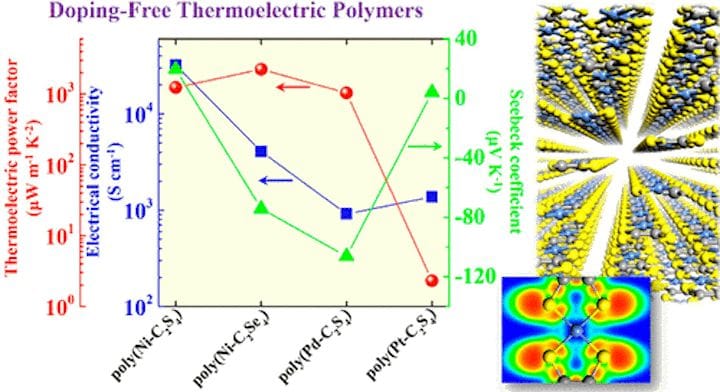![Thermoelectric materials [Source: ACS]](https://fabbaloo.com/wp-content/uploads/2020/05/image-asset_img_5eb0983e2765b.jpg)
I’m reading a paper on the development of thermoelectric polymers, and wondering about its applicability to 3D printing.
If you haven’t heard of thermoelectric materials, you’re missing out! They are substances that can generate electricity from differences in temperature. If, for example, you have a hot side and a cold side, then electricity can be produced.
There has been much research attempting to develop efficient materials of this type, but these researchers out of Singapore seem to have made a bit of a discovery.
The researchers explain:
“It is generally deemed that doping is a must for polymeric materials to achieve their high thermoelectric performance. We herein present the first report that intrinsically metallic behaviors and high-performance thermoelectric power factors can coexist within doping-free linear-backbone conducting polymers, poly(nickel-ethylenetetrathiolate) and its analogs.”
They were able to demonstrate that four particular polymers “exhibit intrinsically metallic behavior” due to the interaction between specific molecules. In other words, they believe these specific polymers could be thermoelectric.
Not being a chemist, I can’t say if these particular polymers would be 3D printable. To do so, they would have to be thermoplastic in nature. “Thermoplastic” means the material can be heated to a softened state, and then re-crystallized to a solid state repeatedly. This is what’s happening in your filament 3D printer, for example, as the material is softened and then hardens once again. Thermoplastic materials also opens up the possibility of recycling.
If these new proposed polymers were thermoplastics, or their characteristics could be integrated with thermoplastics, then we would have another very intriguing material for use in 3D printing.
We’ve already seen electrically conductive filament materials that could carry electrical current or signals through the interior of 3D prints. A thermoelectric material, however, could, in some applications, generate the current to be carried over those paths.
This could be a very interesting form of application, as many mechanical devices struggle with excess heat. If this heat could be somehow converted into power by thermoelectric materials, it may be possible to kill more than one bird with a single stone: keep cool and power the device.
However, at this point these thermoelectric polymers are not only not on the market, they are only theoretical as it seems the researchers have not physically produced them yet.
But their work is definitely one of the steps one must take towards the development of true, commercially available thermoelectric materials.
Via ACS











An inventive designer has developed a method for producing 3D paper objects using recycled paper and 3D printed molds.